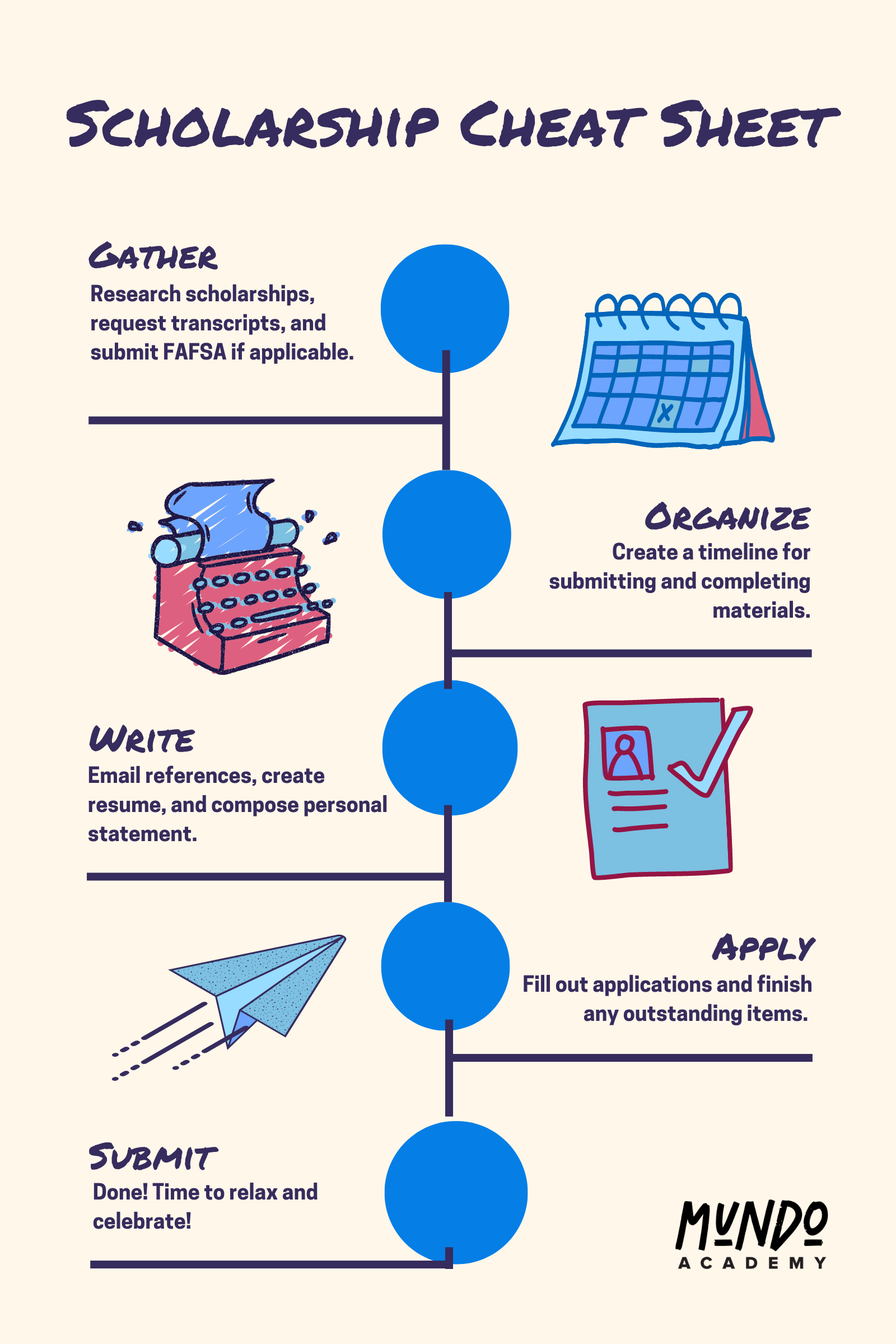Higher education is, well, expensive. Research indicates that the average cost of tuition, fees, and living accommodations for an undergraduate student has ballooned over the last two decades. Scholarships are an ideal way for college-bound students to reduce their financial responsibility. This step-by-step guide will help you apply for (and hopefully receive) some cold, collegiate cash.
Start with some research. Then, organize!
Students qualify for scholarships based on various factors, including academic performance, community service, athletic prowess, musical talent, demographics, financial need, etc. During your search, consider which types of scholarships you might be eligible for and what might be the best fit for you. (For example, a gifted writer might apply for awards showcasing these abilities.) Although many scholarships prize academics or other traditional metrics, you can certainly find opportunities catering to niche talents and interests. Aggregate sites like Scholarships.com or CareerOneStop.org are great resources. You can also check out our Instagram for leads and ideas.
Application deadlines typically span early October through late April, so knowing what is due (and when) is critical! Finding a method for keeping track of deadlines, requirements, application materials, etc.—whether a spreadsheet, bullet journal, Google calendar, or a magical combination thereof, will streamline your application process and hopefully prevent perilous last-minute scrambling. (For those of us who fail to keep a tidy inbox, you could even create a separate email address just for scholarships.)
Okay, okay, organization. Got it. What do I need to submit?
Regardless of scholarship type, you will likely need to submit high school transcripts or diplomas, letters of recommendation, a personal statement or essay, a completed FAFSA (for need-based awards), and a resume. Additionally, applicants may be asked for specific items, i.e., an arts-based scholarship could require a portfolio, etc.
Let’s examine three major components of the application more closely: the resume, the letters of recommendation, and the essay.
The resume:
Generally, resumes are structured with academic awards or distinctions at the top, followed by community service and extracurricular activities. Resumes will typically not include past elementary and middle school successes unless exceptional. (If it isn’t something like publishing a book of poetry, winning a national tennis tournament, or some other Tennebaum-esque feat, it’s best to omit it.)
Do keep in mind the specifics of the scholarship and tweak your resume as needed, i.e., highlight volunteer work for a scholarship predicated on community service involvement.
The letters of recommendation:
Most organizations will ask for recommendations from individuals in a position to evaluate your qualifications, such as educators, mentors, or employers. (If you have recently submitted recommendations as part of your college applications, simply ask your references to reuse those letters.) As a kindness, make it as easy as possible for those folks. Give them ample time to complete the steps, provide them with all the necessary information (your resume, submission materials, etc.), and email them reminders well in advance. (Also, send thank-you notes.)
The essay or personal statement:
The personal statement serves a few critical functions in the application process. It allows the selection committee or organization to gain deeper insight into your accomplishments, form a genuine connection with you, and assess your writing skills. Additionally, it provides space for applicants to discuss sources of support or specific challenges that have influenced their academic trajectories.
As obvious as it sounds, stick to the assigned format and topic. (Some prompts will be more open-ended, and others will have clear parameters.) Much like the recommendations or the resume, if you have recently written essays as part of your college applications, you may be able to purloin components or themes from those submissions.
For a bit of inspiration, read essay examples and note what makes some more successful than others. Ideally, you want to craft something memorable that sets your application apart from the pack. Think of it as storytelling. (Many outstanding essays begin with an anecdote, allowing the author to assign meaning to the experience and reflect on their personal growth, character, and values.) To ensure a strong (and typo-free) submission, have at least one other set of trusted eyes on your writing and leave time to revise, revise, revise.
Do you know of any specific scholarships that are still accepting applications?
Yes! Many scholarships are still available for the upcoming academic year (or beyond). Here are three recently featured on our Instagram:
Awards are open to Latinx students with a 3.00 GPA or higher who demonstrate financial need and are enrolled in the College Match program. Students who display leadership or mentoring within their school or communities will receive special consideration. Qualifying students may receive up to $6,000. The deadline to submit is March 31st, 2024.
Up to $5,000 in funds are available to Latinx students with a high school GPA of 3.00 or higher (or college-enrolled students with a GPA of 2.5 or higher). Submit applications by February 15th, 2024 for consideration.
17th Annual Create-A-Greeting-Card
Applicants ages fourteen or older can win $10,000 in cash and an additional $1,000 for their school. Students will submit an original photo, artwork, or computer graphics for the cover of a greeting card. Submissions are due by June 1st, 2024.
Need help writing a killer personal statement? Mundo is dedicated to supporting students throughout the application process. We offer one-on-one writing sessions with experienced tutors who can assist with planning, polishing, and proofreading. For more information about scholarships or other academic services, please visit our other blogs or contact us directly.



